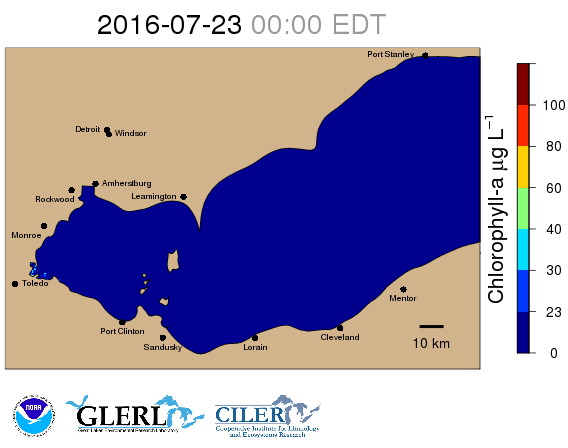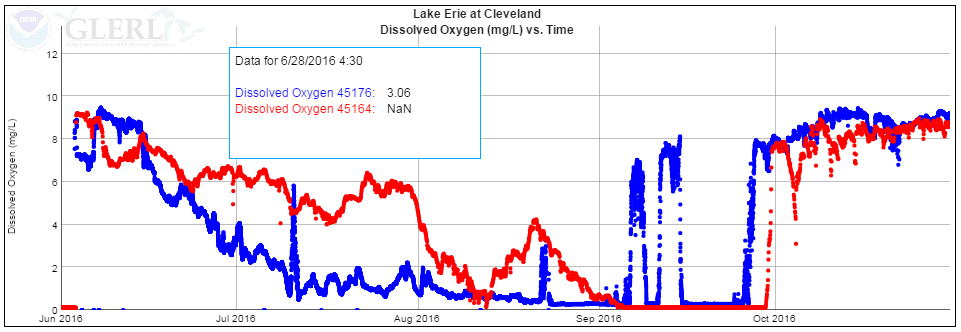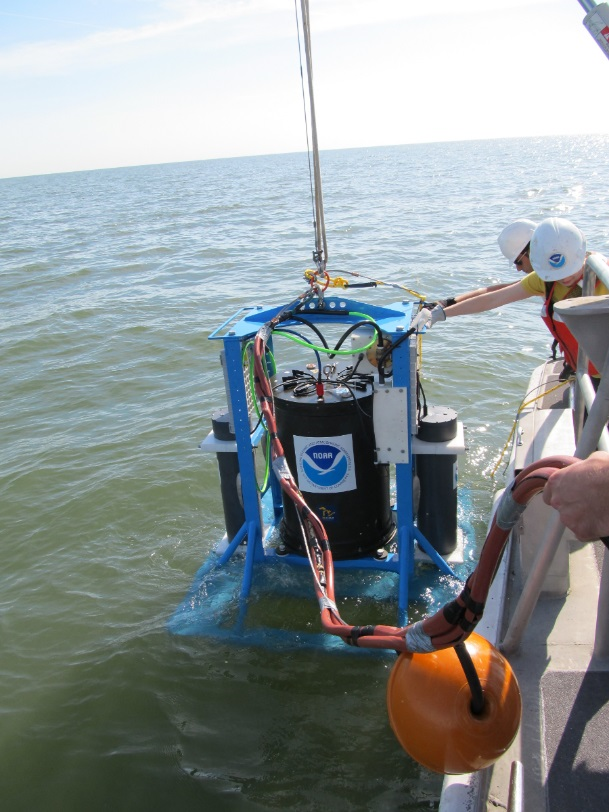Winter 2017 eNewsletter
Featured Research: A Big Data Challenge – Lake Erie Algal Blooms and Hypoxia
By Joeseph Smith, CILER Programmer and Analyst

Figure 1: An example HAB Tracker animation.
One of CILER’s primary functions is to put Great Lakes science in the hands of society. With our partners at NOAA GLERL, we are at the forefront of monitoring and forecasting two major water quality and human health threats in Lake Erie: harmful algal blooms (HABs) and oxygen-depleted water, or “hypoxia.” The foundational goal of this research program is to protect public health by delivering critical information directly to stakeholders, such as water intake and beach managers, so they can prepare for public threats and make informed decisions. That sounds simple enough, but the combination of rapidly-changing lake conditions that promote HABs and hypoxia, the need for managers to react quickly when public health is threatened, and the large volume and variety of data being collected on a daily basis presents a challenge.
In light of this challenge, we are developing innovative processes that transfer real-time and near real-time data from scientists to society. Data from the HABs and hypoxia program are generated using a variety of techniques, including satellite remote sensing, aircraft-mounted sensors (“unmanned aerial systems”), continuous in-lake water quality monitoring, and modeling, resulting in a wide variety of data formats. Thus, a variety of methods are being employed to streamline the data, with the ultimate goal of hosting an interactive online display for public use.
Information about the CILER-GLERL HABs and hypoxia program and data collected within it are aggregated in a portal page on NOAA GLERL’s website. The HABs and hypoxia portal page is an important step toward putting critical data to support decision making in the hands of stakeholders. Features of the HABs and hypoxia portal include:
Water Quality Monitoring
Water quality monitoring is essential for documenting the growth and spread of HABs and hypoxia in Lake Erie. CILER and GLERL collect water quality data during the peak HABs season (June-October) at 8 sites in western Lake Erie, through weekly monitoring trips and continuous buoy and sensor systems. These data are plotted graphically and displayed on the portal page. Data are available to the public for years 2009 to present (weekly monitoring) and 2014 to present (continuous systems).

Figure 2: Example of dissolved oxygen data in Lake Erie near Cleveland, OH, as part of the Hypoxia Warning System, available on the HABs and hypoxia web portal.
Lake Erie HAB Tracker
CILER and GLERL scientists are using our water quality data, along with data collected from NASA satellites, weather forecasts, and water movement forecasts, to predict future HABs in western Lake Erie. They have developed a specialized tool called the HAB Tracker that produces a 5-day forecast of algal bloom movement and size through 3D simulations and graphics (Figure 1). These predictions can provide water intake managers with timely information for public health decision making.
Lake Erie Hypoxia Warning System
Using data collected from three buoys near Cleveland, Ohio, and water movement forecasts, CILER and GLERL scientists have developed a Hypoxia Warning System for central Lake Erie (Figure 2). The system is intended to provide drinking water managers with warnings of water chemistry changes associated with hypoxia and other water movements that impact Cleveland municipal drinking water. These conditions result in water discoloration and odor and taste problems that require changes to drinking water treatment processes. Near real-time access to information on water chemistry near drinking water intakes allows plant managers to prepare for alternate water treatment methods when hypoxic conditions occur.
New Experimental Efforts
NOAA GLERL and CILER scientists are leading new cutting-edge research to advance our understanding of HAB growth, movement, and toxin production. New HABs detecting capabilities are being developed using hyperspectral imaging sensors mounted on an unmanned plane and using a new Environmental Sample Processor (ESP).

Figure 3: ESPniagara being deployed for its first test mission in Lake Erie, June 2016.
In collaboration with NASA’s Glenn Research Center, the team conducts weekly flyovers of western Lake Erie using an unmanned plane equipped with a hyperspectral imaging sensor. Generating HAB images in this way has a distinct advantage over satellite imaging because these systems can detect a greater number of algal groups, collect more information per square mile, and fly under the clouds, thus avoiding missed data due to weather. These hyperspectral images represent an advanced method for identifying the type and location of algal blooms near drinking water intake systems, and will be a valuable resource for drinking water intake managers. The data will be publically available on the GLERL HABs and hypoxia web portal after the initial testing phase is complete.
In 2016, NOAA GLERL and CILER began test deployments of the first Environmental Sample Processor (ESP) to be used in fresh water. The ESPniagara is a “lab in a can” that autonomously collects and analyzes water for microcystin, the dominant toxin produced by HABs, and communicates the results to data servers in near-real time (Figure 3). The ESPniagara can provide drinking water managers with an earlier warning of algal blooms and their toxicity, enabling them to take action to protect public health sooner. After the initial testing phase, the data will be posted on GLERL’s HABs and hypoxia web portal for public access.
About the Project
CILER’s funding for the program is provided by NOAA GLERL, through EPA Great Lakes Restoration Initiative and the NOAA High Performance Computing and Communications Program.
HABs and hypoxia research team: Tim Davis (GLERL lead scientist), Tom Johengen (CILER lead scientist), Eric Anderson (GLERL), Ashley Burtner (CILER), Emily Davenport (CILER), Dave Fanslow (GLERL), Duane Gossiaux (GLERL), Christine Knight (CILER), Kevin Meyer (CILER), Danna Palladino (CILER), Mark Rowe (CILER), Steve Ruberg (GLERL), Joe Smith (CILER), Hank Vanderploeg (GLERL), Andrea Vander Woude (GLERL), Michele Wensman (CILER)
Related Articles & Resources
- Lake Erie HAB Tracker (Animation)
- 2015 Western Lake Erie Harmful Algal Bloom (HAB) Forecast (Bulletin)
- 2016 Western Lake Erie Harmful Algal Bloom (HAB) Forecast (Bulletin)
- In the News
- Stay out of the scum, warns NOAA’s latest bulletin on Lake Erie’s Harmful Algal Bloom; Climate.gov, 8/19/2015
- Tracking harmful algal blooms in Lake Erie; NOAA Press Release, 9/23/2015
- Severe algae bloom forecast; The Advertiser-Tribune, 2/17/2017
